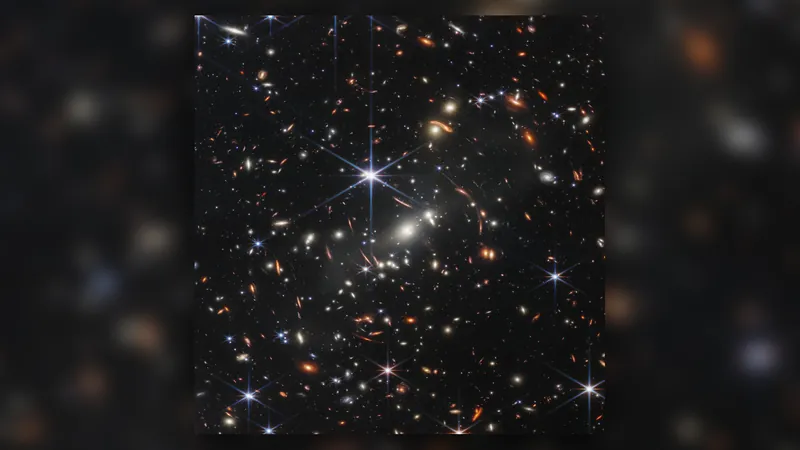
Unlocking the Universe: How Far Can the James Webb Space Telescope See into the Cosmos?
2025-08-03
Author: Ting
The Evolution of Telescopes: A Journey Through Time
It all started in 1608 when Dutch eyeglass maker Hans Lippershey crafted the first telescope, sparking a journey that would forever change our comprehension of the universe. Fast forward centuries, and advancements in telescope technology have propelled us into the cosmic frontier, allowing astronomers to unveil the mysteries of distant stars and galaxies.
Meet the Powerhouse: The James Webb Space Telescope
The title of the most powerful telescope currently belongs to the James Webb Space Telescope (JWST), launched in December 2021. Unlike its predecessor, the Hubble Space Telescope—designed for visible light—JWST specializes in detecting infrared wavelengths. These wavelengths, invisible to the naked eye, allow astronomers to explore celestial phenomena that often elude traditional optical telescopes.
Why Infrared? A Clearer View into the Cosmos
In the vast reaches of space, many objects emit little visible light, rendering them invisible to traditional observation methods. However, infrared light can penetrate clouds of cosmic dust, giving JWST a crucial advantage to explore the universe's furthest corners. Even with cutting-edge technology, the Vera C. Rubin Telescope in Chile can't reach the same distances, hindered by its own limitations.
A Glimpse into the Early Universe
The JWST has turned back the cosmic clock, giving us a view of galaxies dating back approximately 13.7 billion years. Peter Jakobsen, an astrophysicist at the University of Copenhagen, shared, "The James Webb Space Telescope has proven itself capable of seeing 98% of the way back to the Big Bang—a feat beyond our initial aspirations!"
What Makes JWST So Powerful?
At the core of JWST's capabilities lies its massive primary mirror, measuring 21.3 feet (6.5 meters) in diameter, compared to Hubble's comparatively smaller 8-foot mirror. This immense collecting area allows JWST to capture more light, opening the door to insights beyond Hubble’s reach while operating beyond the atmosphere's distortions.
Revolutionizing Cosmic Observation from Space
Positioned nearly 1 million miles from Earth at a stable Lagrange point, JWST enjoys a strategic advantage over ground-based telescopes. Freed from atmospheric turbulence and light pollution, it delivers clearer, more detailed cosmic images.
Peering Back in Time: The Intricacies of Cosmic Distance
When we gaze up at the night sky, we are essentially looking back in time. Light from distant objects takes eons to reach us, and astronomers must contend with the universe's expansion and the finite speed of light. By analyzing redshift—the phenomenon of light stretching as celestial bodies move away—scientists navigate these complexities to estimate distances.
Farthest Known Galaxies: Unraveling Cosmic Mysteries
Among the furthest known galaxies identified by JWST is JADES-GS-z14-0, estimated to be 290 million years old, and its potentially even older rival, MoM-z14, dating back only 280 million years after the Big Bang. These discoveries suggest that our understanding of the universe continues to evolve.
A New Era of Exploration on the Horizon
While the JWST currently reigns supreme in cosmic exploration, new contenders loom on the horizon. China is developing the China Space Station Telescope, engineered to capture a broader array of light wavelengths than JWST, promising to open yet further avenues for cosmic discovery.



 Brasil (PT)
Brasil (PT)
 Canada (EN)
Canada (EN)
 Chile (ES)
Chile (ES)
 Česko (CS)
Česko (CS)
 대한민국 (KO)
대한민국 (KO)
 España (ES)
España (ES)
 France (FR)
France (FR)
 Hong Kong (EN)
Hong Kong (EN)
 Italia (IT)
Italia (IT)
 日本 (JA)
日本 (JA)
 Magyarország (HU)
Magyarország (HU)
 Norge (NO)
Norge (NO)
 Polska (PL)
Polska (PL)
 Schweiz (DE)
Schweiz (DE)
 Singapore (EN)
Singapore (EN)
 Sverige (SV)
Sverige (SV)
 Suomi (FI)
Suomi (FI)
 Türkiye (TR)
Türkiye (TR)
 الإمارات العربية المتحدة (AR)
الإمارات العربية المتحدة (AR)